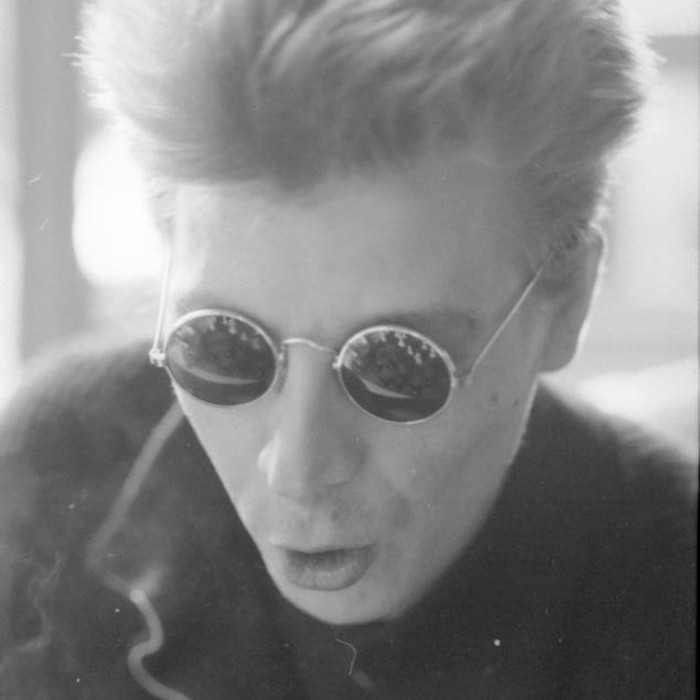
Artiste-professeur invité
2000 - 2001
Jean-Marc Musial
Born in 1966 in Lille (France)
Multimedia artist, stage director, film-maker, video artist, visual artist, artistic director, teacher.
Jean-Marc Musial is an artist, director and producer. He began directing art theatre with Quartett by Heiner MÜLLER (1991), Haute Surveillance by Jean Genet (1992) and Orgie by Pasolini (94) at the Théâtre National de Lille and La Rose des Vents. In addition to Orgie and the national stages, he created MILCZENIE (Silence! in Polish). This long silent poem based on the biomechanics of movement is a tribute to the brilliant Russian director Vsevolod Meyerhold, assassinated in 1940 by the Stalinist regime. The circumstances of his death were not made public until 1989.
Virginie Di Ricci studied History and theatre practice before joining Jean-Marc Musial's theatre research laboratory in 1995 as an actress, dramaturge and editor. Together, they founded the ATTILA laboratory (Action Théâtre Technologie Image Laboratoire Artistique) in 1997, focusing their research and practice on cinematographic theatre and the digital stage. They produce multimedia works linked to questions of art and power. Their dramaturgies synthesise multiple textual, iconographic, sound and archaeological sources. In 1997, with Straszny ! ("Intolerable!" in Polish), they created a gigantic 360° happening in a circular seventeenth-century church, inspired by their research into the European avant-gardes of the early twentieth century.
In 1998, they spent some time in Barcelona and began researching the Spanish Civil War and its archives. They created two monologues, "Le mort de Georges BATAILLE" and "VAN GOGH le suicidé de la société" by Antonin ARTAUD (Nuit Blanche Lille and Espace Pasolini 1999). From 1998 to 2000, they devoted themselves to Sadian mental theatre and the French Revolution. Using the work of the Marquis de SADE as well as that of Jules Verne and Alfred JARRY, they sought to realise the idea put forward by Annie LEBRUN of "a theatre without bottom / theatre without end". Three creations performed and filmed live punctuate this research: "Ou la nature dévoilée" (presented in 1998 in the video station Heure Exquise), "Les journées de Florbelle" at (l'Espace Pasolini de Valenciennes 1999), "SADE/Charenton, les larmes de sang" (1st Biennale of Emerging Arts in Turin 2000).
In 2000/2001, Jean-Marc Musial was a guest lecturer at Le Fresnoy. There, with Virginie Di Ricci, he created CALDERON, La représentation de la représentation, a palimpsest work by Pier Paolo Pasolini, tracing Spanish history from Velasquez's Meninas to the post-Franco period. This rose-shaped tragedy, combining theatre, film, video and computer-generated images, was presented at the 1st Biennale des Arts Numériques de la Villette /Paris and at the Phénix in Valenciennes (2002).
In 2004, they were awarded the Villa Médicis hors les Murs prize for "Stage Direction and Set Design". Together in Rome, they created ROMA AMOR using fragments of Latin political and poetic texts from the first century of the Roman Empire: Vrgilus, Suetonius, Tacitus, Seneque, Lucan and Martial. The set design is virtual and the performance is masked. On the technological front, they have teamed up with R&D engineers Eric Nivel and Vincent Foucke to create an artificially intelligent stage.
Then their creative process - inspired by the work of Edward Gordon CRAIG and Tadeusz KANTOR - led them to leave the performance space for the exhibition space. With ROMA AMOR, they realised their idea of an anthropomorphic theatre in which the actors are the ancient works themselves: Julio-Claudian portraits, acephalous statues, divinities and other fragments from the 1st century preserved in archaeological museums merged with the digital work at the Musée St Raymond in Toulouse in 2007, then at the National Archaeological Museum in Tarragona (Catalonia) in 2008. Their technological autonomy in terms of the creation and display of images and sounds gives them the flexibility and inventiveness to adapt to different configurations and exhibition venues. In parallel with 'ROMA AMOR', and in a reborn gesture towards the ancient world, they are anchoring their next visual creation in the rite of Isis and Osiris and the counter-images of Egyptian death. For the theatre, it's Antonin Artaud. Independent artists, they have lived and worked in Paris since 2006.
